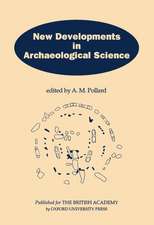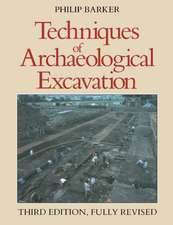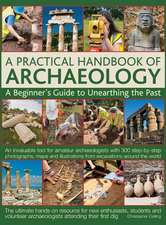Elements of Architecture: Assembling archaeology, atmosphere and the performance of building spaces: Archaeological Orientations
Editat de Mikkel Bille, Tim Flohr Sorensenen Limba Engleză Hardback – mar 2016
This volume juxtaposes archaeological research with perspectives from anthropology, architecture, cultural geography and philosophy in order to explore the kaleidoscopic intersections of elements coming together in architecture. Documenting the ephemeral, relational, and emotional meeting points with a category of material objects that have defined much research into what it means to be human, Elements of Architecture elucidates and expands upon a crucial body of evidence which allows us to explore the lives and interactions of past societies.
| Toate formatele și edițiile | Preț | Express |
|---|---|---|
| Paperback (1) | 312.43 lei 6-8 săpt. | |
| Taylor & Francis – 12 dec 2019 | 312.43 lei 6-8 săpt. | |
| Hardback (1) | 1306.55 lei 6-8 săpt. | |
| Taylor & Francis – mar 2016 | 1306.55 lei 6-8 săpt. |
Preț: 1306.55 lei
Preț vechi: 1967.94 lei
-34% Nou
Puncte Express: 1960
Preț estimativ în valută:
250.04€ • 271.50$ • 210.03£
250.04€ • 271.50$ • 210.03£
Carte tipărită la comandă
Livrare economică 22 aprilie-06 mai
Preluare comenzi: 021 569.72.76
Specificații
ISBN-13: 9781138775411
ISBN-10: 113877541X
Pagini: 462
Ilustrații: 106
Dimensiuni: 174 x 246 x 30 mm
Greutate: 1.2 kg
Ediția:1
Editura: Taylor & Francis
Colecția Routledge
Seria Archaeological Orientations
Locul publicării:Oxford, United Kingdom
ISBN-10: 113877541X
Pagini: 462
Ilustrații: 106
Dimensiuni: 174 x 246 x 30 mm
Greutate: 1.2 kg
Ediția:1
Editura: Taylor & Francis
Colecția Routledge
Seria Archaeological Orientations
Locul publicării:Oxford, United Kingdom
Cuprins
Into the Fog of Architecture
Mikkel Bille & Tim Flohr Sørensen
On Behalf of Form: The view from archaeology and architecture
Graham Harman
Part I: Form and Temporality
On Shaping Buildings
Mikkel Bille & Tim Flohr Sørensen
Immanent Architecture
Lesley K. McFadyen
Big Affects: Size, Sex and Stalinist ‘Architectural Power’ in Post-Socialist Warsaw
Michal Murawski
Architecture in Ruins: Palladio, Piranesi and Kahn
Jonathan Hill
Building Lives
Gavin Lucas
Archaeologies of an Informal City: Temporal dimensions of contemporary Andean urbanism
Alison Kohn & Shannon Lee Dawdy
Brussels’ Conflicting Constructs
Mark Minkjan & Ingel Vaikla
Part II: Atmospheres
A Sense of Place
Mikkel Bille & Tim Flohr Sørensen
Lighting up the Atmosphere
Tim Ingold
Traffic Architecture – Hidden affections
Jürgen Hasse
Affective Architecture in Ardnamurchan: Assemblages at three scales
Oliver J. T. Harris
A Sense of Architecture in the Past: Exploring the sensory experience of architecture in archaeology
Serena Love
Part III: Performance and process
Architecture in Motion
Mikkel Bille & Tim Flohr Sørensen
Politics of Architectural Imaging: Four ways of assembling a city
Albena Yaneva
Homeless, Home-Making, and Archaeology: ‘To be at home wherever I find myself’
Larry J. Zimmerman
Into Architecture: House-building and acentered personhood in Maputo, Mozambique
Morten Nielsen
Sedimentation and Sentiment: Destabilizing architecture at the post-industrial Mexican periphery
Jason Ramsey
Performance Architecture: Absence, place and action
Nick Kaye
Reframing the Ziggurat: Looking at (and from) ancient Mesopotamian temple towers
Augusta McMahon
Part IV: Disintegration and unfinishedness
Architecture Becoming New Spaces
Mikkel Bille & Tim Flohr Sørensen
Incipient Ruination: Materiality, destructive agencies and repair
Tim Edensor
For Love of Ruins
Þóra Pétursdóttir
Unfinishing Buildings
Michael A. Ulfstjerne
The Disconnected Experience of Some Designed Places
Jørgen Ole Bærenholdt
Failure? An archaeology of the architecture of nuclear waste containment
Rosemary Joyce
Index
Mikkel Bille & Tim Flohr Sørensen
On Behalf of Form: The view from archaeology and architecture
Graham Harman
Part I: Form and Temporality
On Shaping Buildings
Mikkel Bille & Tim Flohr Sørensen
Immanent Architecture
Lesley K. McFadyen
Big Affects: Size, Sex and Stalinist ‘Architectural Power’ in Post-Socialist Warsaw
Michal Murawski
Architecture in Ruins: Palladio, Piranesi and Kahn
Jonathan Hill
Building Lives
Gavin Lucas
Archaeologies of an Informal City: Temporal dimensions of contemporary Andean urbanism
Alison Kohn & Shannon Lee Dawdy
Brussels’ Conflicting Constructs
Mark Minkjan & Ingel Vaikla
Part II: Atmospheres
A Sense of Place
Mikkel Bille & Tim Flohr Sørensen
Lighting up the Atmosphere
Tim Ingold
Traffic Architecture – Hidden affections
Jürgen Hasse
Affective Architecture in Ardnamurchan: Assemblages at three scales
Oliver J. T. Harris
A Sense of Architecture in the Past: Exploring the sensory experience of architecture in archaeology
Serena Love
Part III: Performance and process
Architecture in Motion
Mikkel Bille & Tim Flohr Sørensen
Politics of Architectural Imaging: Four ways of assembling a city
Albena Yaneva
Homeless, Home-Making, and Archaeology: ‘To be at home wherever I find myself’
Larry J. Zimmerman
Into Architecture: House-building and acentered personhood in Maputo, Mozambique
Morten Nielsen
Sedimentation and Sentiment: Destabilizing architecture at the post-industrial Mexican periphery
Jason Ramsey
Performance Architecture: Absence, place and action
Nick Kaye
Reframing the Ziggurat: Looking at (and from) ancient Mesopotamian temple towers
Augusta McMahon
Part IV: Disintegration and unfinishedness
Architecture Becoming New Spaces
Mikkel Bille & Tim Flohr Sørensen
Incipient Ruination: Materiality, destructive agencies and repair
Tim Edensor
For Love of Ruins
Þóra Pétursdóttir
Unfinishing Buildings
Michael A. Ulfstjerne
The Disconnected Experience of Some Designed Places
Jørgen Ole Bærenholdt
Failure? An archaeology of the architecture of nuclear waste containment
Rosemary Joyce
Index
Recenzii
"[...]the concepts worked with here are crucial to emerging ideas about atmosphere, the senses, movement, and assemblage in archaeology. If you are looking for new ways to think about the discipline and how we come to know things, this pretty, curious, and deliberately vague volume will be useful."
Dr. Corin C.O. Pursell, Gardener
Dr. Corin C.O. Pursell, Gardener
Descriere
Elements of Architecture explores new ways of engaging architecture in archaeology. It conceives of architecture both as the physical evidence of past societies and as existing beyond the physical environment, considering how people in the past have not just dwelled in buildings but have existed within them. The book engages with the meeting point between these two perspectives. For although archaeologists must deal with the presence and absence of physicality as a discipline, which studies humans through things, to understand humans they must also address the performances, as well as temporal and affective impacts, of these material remains. The contributions in this volume investigate the way time, performance and movement, both physically and emotionally, are central aspects of understanding architectural assemblages. It is a book about the constellations of people, places and things that emerge and dissolve as affective, mobile, performative and temporal engagements.
This volume juxtaposes archaeological research with perspectives from anthropology, architecture, cultural geography and philosophy in order to explore the kaleidoscopic intersections of elements coming together in architecture. Documenting the ephemeral, relational, and emotional meeting points with a category of material objects that have defined much research into what it means to be human, Elements of Architecture elucidates and expands upon a crucial body of evidence which allows us to explore the lives and interactions of past societies.
This volume juxtaposes archaeological research with perspectives from anthropology, architecture, cultural geography and philosophy in order to explore the kaleidoscopic intersections of elements coming together in architecture. Documenting the ephemeral, relational, and emotional meeting points with a category of material objects that have defined much research into what it means to be human, Elements of Architecture elucidates and expands upon a crucial body of evidence which allows us to explore the lives and interactions of past societies.
Notă biografică
Mikkel Bille is Associate Professor at the Department of Environmental, Social and Spatial Change, Roskilde University, where his research centers on the role of things and technologies from the recent past in contemporary society.
Tim Flohr Sørensen is Assistant Professor at the Department of Archaeology, University of Copenhagen, where his research is focused on archaeological theory and themes in prehistoric and contemporary archaeology.
Tim Flohr Sørensen is Assistant Professor at the Department of Archaeology, University of Copenhagen, where his research is focused on archaeological theory and themes in prehistoric and contemporary archaeology.




















